| NNNN
BAD
DEVELOPERS
NNNN |
|
EXPOSING
DEVELOPERS WHO FAIL TO APPRECIATE AND RESPECT COMMUNITY, ENVIRONMENT AND
SPIRIT OF THE LAND
|
|
|
Gippsland Lakes
The Lakes are Getting Saltier.
Roughly the invasive species identified so far have been: Green
European Shore Crab; Stingray; Draughtboard Shark; Leopard Shark; Gummy Shark;
Hammerhead Shark; Thresher Shark; Squid and a wide range of marine fish
One large source of Mercury into the Gippsland Lakes was the
Maryvale
Pulp Mill - Gold mining and coal
mines have been other large sources.
Minister Lisa Neville said pregnant women concerned about mercury
levels should consult their doctors and make the best decisions for their families.
"There's new information that has come forward through the doctors in Gippsland
and I think we need to take that seriously, that's why a study is being undertaken
and ensure the community have all the information they need," she said. "Most
people are advised to have two or three pieces of fish, if you are pregnant,
it is always advisable to have much less than that anyway, but certainly in
this case I'd be suggesting that pregnant women take all precautions, see their
doctor and make that decision that's in their best interest and their families'
best interest."
The three doctors conducted their own tests on black bream
caught in the lakes, and supplied ABC News with the laboratory analysis. The
analysis showed all 10 samples had mercury levels higher than the maximum safe
level recommended by the Australian and New Zealand Food Standards Code. In
one sample, the mercury level was more than four times the maximum safe level.
Despite the doctors' urging, Victoria's Environmental Protection Authority (EPA)
last tested for mercury in the sediment of the lakes in 2004, and the fish had
not been tested since 1997.
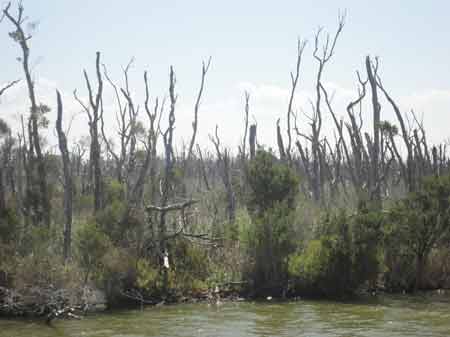
2015 February: McLennan Straits - massive vegetation kill. Some salt
tolerant plants are reestablishing.. The kill is a shocking demonstration
of what we have been on about since soon after the deepening of the entrance
in 2008 that resulted in a greatly increased tidal prism.( amount of marine
water entering)
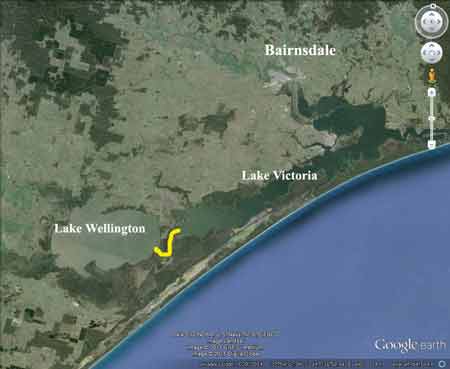
McLennan Straits connects Lake Wellington with Lake Victoria. It is approximately
50km south west of Lakes Entrance.
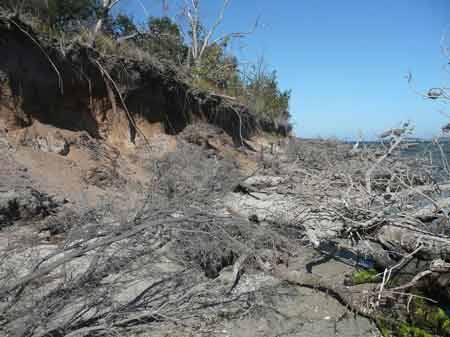
Shoreline Erosion occurring after deepening of the entrace of the Lakes
in March 2008 - Banksia Peninsula, Gippsland Lakes
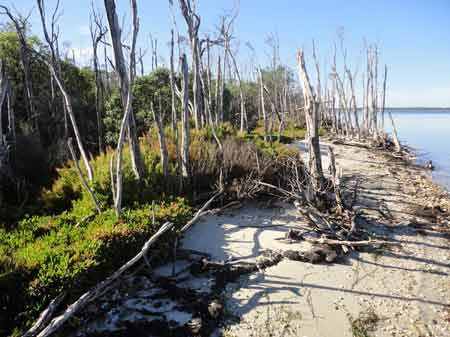
Shoreline Erosion occurring after deepening of the entrace of the Lakes
in March 2008 - Banksia Peninsula, Gippsland Lakes
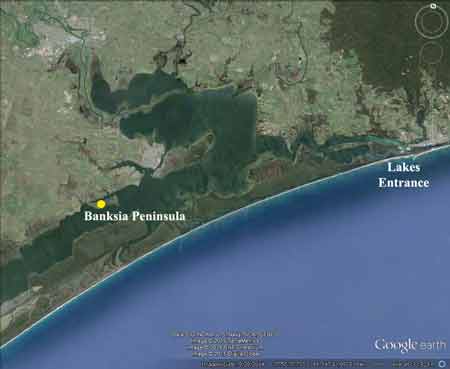
Rising salinity levels in the world-renowned Gippsland Lakes
is putting the wetlands at risk, with a recent government report acknowledging
it did not know the long-term risks of the problem.
Salinity levels have risen dramatically in recent years, threatening
the ecosystem. The shoreline has been eroded and vegetation and fish species
are dying.
In an effort to combat the problem, the Gippsland Lakes Ministerial
Advisory Committee has suggested replacing freshwater vegetation with salt-resistant
plants. However, former government bureaucrat and environmental activist Ross
Scott said a salinity barrier was needed to help stop levels from increasing.
He suggested more regular monitoring to ensure authorities knew the scope of
the problem.
"The saltwater wedge has now progressed up the lake chain as
far as the Port of Sale, and the high salinity in the Latrobe River threatens
the adjoining Dowd and Heart Morass," he said.
The community had spent $2.5 million recently to buy low-lying
farmland to protect and expand the Heart Morass, only to have it at risk now
from salt, he said.
The Environment Protection Authority tests salinity levels
at five spots in the lake monthly. The Gippsland Lakes cover 600 square kilometres
in Victoria's south-east and support the local economy through fishing, tourism
and recreation.
The recent Gippsland Lakes Ministerial Advisory Committee's
environment strategy said it the long-term impact on the ecosystem of increasing
salinity was still not known. It recommended an assessment of whether installing
salinity barriers would increase understanding of the problem.
Managing director Martin Richardson said the lakes were made
up of various ecological values, some of which were naturally marine. Monitoring
was undertaken. "Variability in salinity in the Gippsland Lakes is now almost
solely the result of variability in freshwater inflows from the main rivers
and periods of low river discharge are strongly correlated with periods of high
lakes salinity, and vice versa," he said.
"There's no suggestion there is above acceptable level and
it's not causing a major problem. But there are subtle changes."
The wetlands are listed under the Ramsar Convention because
of their importance to many endangered and threatened waterbird species. They
are also listed in the Japan Australia Migratory Bird Agreement and China Australia
Migratory Bird Agreement.
Salinity levels have rapidly increased since dredging in 2008,
which almost doubled the port depth to 5.5 metres. A lack of freshwater inflows,
evaporation and the permanent entrance to the ocean via Lakes Entrance have
all contributed to the problem.
The latest Natural Assets Report Card graded the lake's health
as "moderate" - 62 per cent of the water meets guidelines, but fish were considered
"poor" because the numbers have plummeted since the 1990s.
Gippsland East MLA Tim Bull, however, disagrees. He said
on the advice of experts, neither the mercury levels in sediment or mercury
levels in fish were of concern. "On the first point, I note the comments of
the acting chief medical officer, Dr Michael Ackland, who has denied mercury
levels in the Gippsland Lakes are any sort of human risk," Mr Bull said.
August 14 2014: MEDIA RELEASE The Gippsland Lakes – a health
reality check is needed now
Will our Gippsland Lakes survive? Will their outstanding beauty
disappear forever, or can we act now to prevent an environment disaster?
These are questions asked by Gippsland 2020 - A Vision for
a 21stCentury Gippsland initiative.
We should all be concerned by the recent ‘Snapshot of the Health
of the Gippsland Lakes’ document contained in the Gippsland Lakes Ministerial
Advisory Committee’s (GLMAC) annual report. It provides disturbing evidence
of declining water quality, high nutrient inflows, continued seasonal algal
blooms (including the dangerous blue-green algae), loss of sea grass, declining
fish stocks and a decrease in the abundance and diversity of bird life. The
alarming report, however, fails to highlight many other significant and immediate
threats affecting the health of the Gippsland Lakes.
‘What GLMAC tell us in the media versus their reports and the
true health of the Lakes are two different things’, according to the former
General Manager of Lake Wellington Rivers Authority, engineer and long-time
Gippsland Lakes resident, Mr Ross Scott. ‘If you compare the health of our Lakes
from a 1960 baseline with the Lakes now, there is no comparison’ he revealed.
‘We have seriously polluted our Lakes with industrial waste from coal mines,
gas operations and we have sold off the farm by diverting fresh, surface water
inflows to Melbourne and away from the Lakes since the 1980's. We have effectively
traded our Gippsland Lake's important fresh water supplies- their lifeblood-
for unsustainable residential development around Melbourne’.
These serious environmental issues have been compounded since
2008 by the increased volume of sea water flowing into the Lakes. The ever-deeper
dredging of the harbour entrance has allowed salt water to infiltrate the fresh-water
Lakes, further disrupting the delicate ecosystem balance according to EPA, CSIRO
and Australian government reports.
Since the economy of East Gippsland relies upon a healthy Gippsland
Lakes ecosystem for its ongoing sustainability and survival, Gippsland 2020
is calling for an immediate commitment by the Victorian Coalition Government
to implement a robust and unbiased audit of the ecological function of the Gippsland
Lakes. Such an independent audit was last carried out by the CSIRO in 1998.
Gippsland 2020 believes that Gippslanders have waited too long
for an independent and scientifically rigorous investigation of the Gippsland
Lakes.
Gippsland 2020 therefore encourages the Victorian Coalition
Government to commit to an independent Audit of the Ecological Function of the
Gippsland Lakes, and to act on eliminating the major threats to the Lakes before
the next Victorian State Election, scheduled for 29 November 2014.
The East Gippsland economy is dependent upon the long-term
sustainability of the once proud Gippsland Lakes ecosystem. An ecological audit
must be completed and corrective action taken before our Lakes are irreversibly
damaged.
A Gippsland Lakes reality heath check is dangerously overdue.
We must act now to prevent an environmental disaster.
References:
http://www.gippslandlakes.net.au/about-us/our-focus/glmac_annual_report_web/
http://www.gcb.vic.gov.au/publications/csiro/CSIRO1998.pdf
http://www.gippslandlakes.net.au/reports/gippsland-lakes-natural-assets-report-card-full-report.pdf
http://www.gippslandlakes.net.au/reports/gippsland-lakes-report-card.pdf
Table 5.1: http://www.environment.gov.au/system/files/resources/0c0185c8-8e0b-4194-a6ca-d0f795bef410/files/21-ecd-ch-4-5.pdf
http://www.environment.gov.au/water/publications/environmental/wetlands/21-ecd.html
In 2008 Gippsland Ports obtained a permit to deepen the entrance
from the sea into the Gippsland Lakes to a depth of 3.5 metres, but they were
permitted to over dredge to 5.5 metres to allow for infill between dredging
cycles. In 2011 a permit was issued to Ports that allowed them to dredge deeper
to 4.5 metres as a target depth. Currently Ports through extensive dredging
is maintaining the entrance at 6 to 7 metres, double the depth that the previous
dredger April Hamer could attain and double the entrance cross-sectional area.
In 1980 Geoff King of the Department of Minerals and Energy
wrote on salt water intrusion through the entrance. He described a maintained
entrance to the sea as a salt pump. Salt ocean water in and fresh lake’s water
out per tidal change.
Gippsland Lakes Ministerial Advisory Committee has describe
the claim that ‘the deepened entrance has resulted in increased salinity in
the lakes’ as a “MYTH”.
The 2013 EPA report into the Gippsland Lakes stated, “The
Gippsland Lakes are characterised by a strong east to west salinity gradient
corresponding to the increasing influence of ocean waters. Salinity levels are
driven by proximity to the entrance and is produced by the saltwater input at
the entrance”. Further, “The lakes have been modified and the entrance
has been dredged even deeper, and this has had a profound modification. Increased
salinity stimulates the release of dissolved nutrients from the lake’s system.”
and, “The high levels of surface water salinity threatens the surrounding
freshwater swamps and wetlands”. The EPA report explains that the eastern
lakes are generally salt stratified with low dissolved oxygen; and that this
condition is conducive to the release of nutrients from the lake’s sediment.
The released nutrients are then available to feed algal blooms.
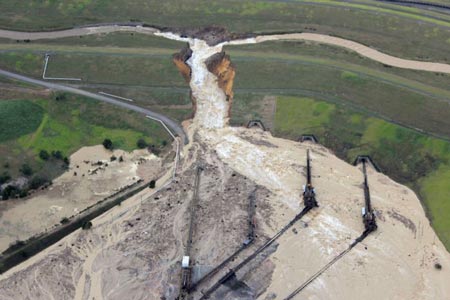
Photo: ABC
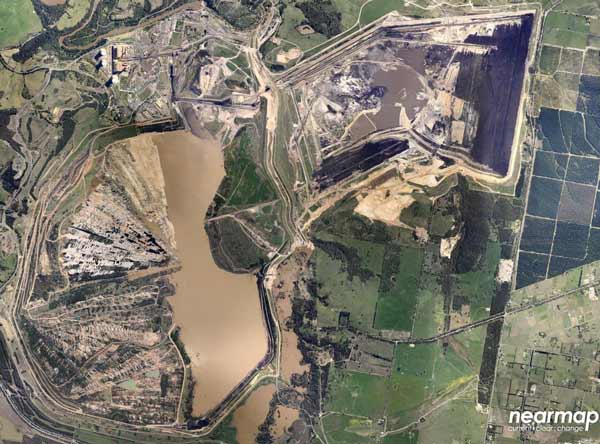
October 3 2012: Image Courtesy of Nearmap. Water had been sitting in
Lake Yallourn for over 4 months.

Yallourn coal hole or is that Lake Yallourn July 2012: All of this
water will eventually evaporate or get pumped out into the Latrobe River and
end up in the Gippsland Lakes, where it will do what?

Interesting
article on source of mercury contaminating Gippsland Lakes (here)
30% of 50 remaining unique Gippsland Lakes dolphins have died since November
2006, some heavily covered with fist-sized fungal skin lesions that had penetrated
deep into the dolphins’ blubber layer.

Distance of Yallourn to western edge of Gippsland Lakes
~75km

Breach of Morwell Diversion occurred at approximate location of top yellow
dot in map, with water entering mine from north east direction. Water
also flooded into the eastern coal hole caused by a build up of flood water
backing up along the Morwell River. This has created an impressive water fall.
(image below - The Age).
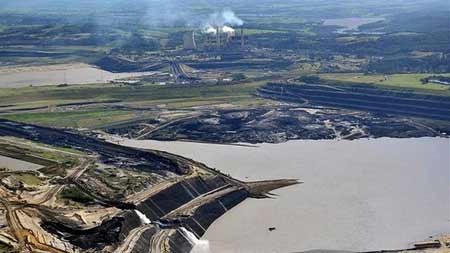

Red swimmer crab, (Nectocarcinus integrifrons) very common in SA; Lives
in seagrass beds. Also See information here about European
Shore Crab (another recent import).
July 26 2010: More invaders into the lakes.
Fishermen caught more of them last night near Metung. A Leopard shark was
also caught by him in this area, but in one of the channels closer to the
coast. As he has been fishing the lakes all of his life and has never seen
these crabs before, I suppose the question now is when did they arrive and
how the hell did they get here.

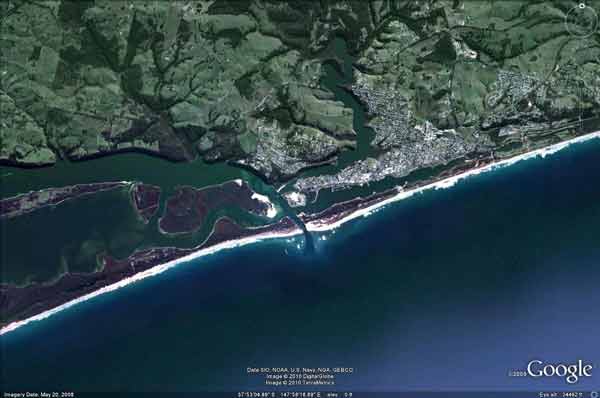
"The Marine Board of Victoria recently relaxed a long standing ban
on commercial passenger vessels using the entrance, but these boats - mostly
fishing charters - can still be put at risk if weather conditions change unexpectedly
whilst they are at sea. The same applies to privately-owned recreational fishing
boats and yachts, which are based in or launched in the Lakes and utilise
the entrance when conditions are appropriate. Upgrading the entrance would
increase the appeal of Lakes Entrance as an ocean access point for a wide
range of vessels, including cruising yachts which currently may be deterred
from attempting to cross the bar. There may be potential for a fast ferry
service to Tasmania, servicing Canberra and the Sydney-Melbourne coastal drive.
With the recent clsoure of the Esso base on Bullock Island, servicing
of offshore oil and gas fields is carried out from ports in Corner Inlet,
mainly Barry's Beach. As the fields to the east, such as Patricia, Baleen
and Kipper, are progressively developed, there is an opportunity for Lakes
Entrance - with its substantial advantage in steaming time - to become the
base for construction and subsequent maintenance. (It is, however, acknowledged
that these fields are unlikely to involve production platforms that require
regular supply and servicing. The port would also be capable of use for shipping
general cargo, such as timber and timber products." East Gippsland
Taskforce Major Projects Status Report. Lakes Entrance Port Redevelopment.
June 2001.
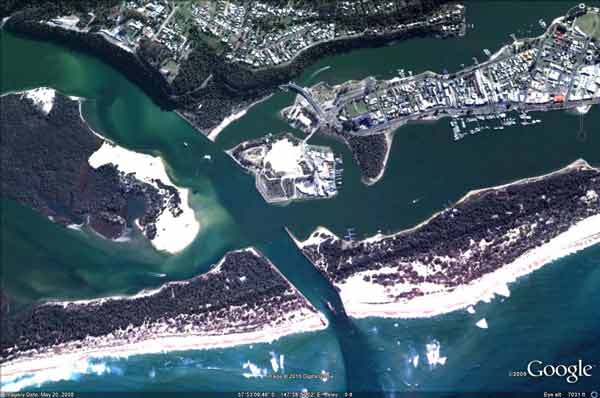
The mouth at Lakes Entrance, constant dredging is allowing vast quantities
of sea water into the Lakes System
Some interesting quotes from a long buried report
Royal Society of Victoria Proceedings Vol 91 & 92 9 March 1981
11 TIDAL SCOUR IN THE GIPPSLAND LAKES by Geoffrey King
"The opening of the artificial entrance in June 1889 made a permanent
connection with the sea and subjected the Lakes to greater tidal influence.
The most immediate effect must have been an increase in salinity followed
by major ecological changes...The flood flow however entered the system as
a dense saline wedge creating bottom currents well into the Lakes system...The
intrusion of the sea into the Lakes began with an unexpected breakthrough
by storm waves in June 1889. This completed the artificial cut in the barrier
that had begun nearly 20 years prior. Tidal currents quickly scoured the entrance
to a navigable depth and Reeves Channel became a tidal channel through which
ebb and flood currents moved in response to the tidal level at the entrance.
The 12km meandering passage into the main body of the Lakes was a significant
constriction to the tidal flow and tidal levels in Lake King were greatly
diminished relative to the entrance....In terms of the salinity pattern, the
Lakes can be classified as a mixed estuary (Drake 1976) i.e. a nett landward
flow of saline water and a seaward flow of less saline lake water. The degree
of saline intrusion is determined by the fresh water head relative to the
tidal strength. In periods of exceptionally high river discharge there is
no intrusion of sea water. Conversely, during periods of low river flow when
evaporation exceeds fresh water inflow, there is a large nett inflow of saline
water. During flood tide the saline wedge moves along the bottom at a velocity
ranging from an average of 50cm/sec in Reeves Channel to 10-15 cm/sec in Lake
King...Therefore it is clear that the scour is caused by the movement of saline
bottom water into the lake...
Salinity in the Lakes was the subject of a Parliamentary Public Works
Committee inquiry in 1952; it concluded that there had not been an appreciable
increase in salinity of the Lakes as a result of the artificial opening. Bird
(1978) however provides evidence based primarily on Phragmites die back, to
support a hypothesis of salinity increase since 1889, and the results of this
investigation add substantially more weight to the conclusion of salinity
increase. The scour channel that has developed in Reeves Channel now provides
a significantly deeper passage for the exchange of water between the main
body of the Lakes and Bass Strait. This has increased saltwater intrusion
into the Lakes system by reducing the mean velocity of the lake water outflow
but also a smaller proportion of the water column is affected by the outflow
during ebb tide (Hinwood 1964)...Thus saline water is pumped into the Lakes
and only exported after vertical mixing with lake water.
IT SEEMS INCONESTABLE THAT SALINITY INCREASE WITHIN THE LAKE SYSTEM HAS
OCCURRED AS A DIRECT RESULT OF THE ARTIFICIAL OPENING OF THE LAKES. THE RESULTS
OF THIS STUDY HIGHLIGHT THE FACT THAT A CONTINUED DEEPENING OF THE LAKE BOTTOM
DUE TO SCOUR IS CAUSING A STEADY INCREASE IN THE SALINITY OF THE LAKES. IT
IS CONTESTED THAT THIS IS OCCURRING DUE TO THE INABILITY OF THE EBB CURRENT
TO FLUSH OUT THE SALINE BOTTOM WATER WHICH INTRUDES DURING FLOOD TIDE...
THE SALINITY OF THE LAKES IS BELIEVED TO BE STEADILY INCREASING BY INTRUSION
OF SALINE WATER ALONG THE SCOUR CHANNELS DURING FLOOD TIDE, AND LITTLE OR
NO FLUSHING OF THIS LOWER LAYER OF SALINE WATER DURING EBB TIDE..."
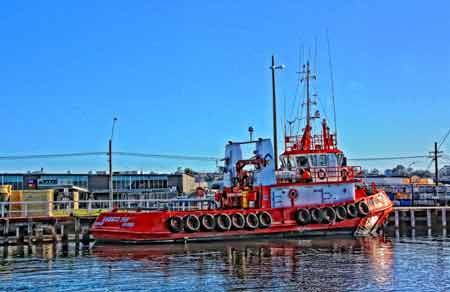
Is this the main reason why the Lakes are suffering from Saltwater Intrusion?
For these large tugs to keep working with the Bass
Strait Oil & Gas Industry?

European Shore Crab/Green Shore Crab
Hundreds of Thousands of European Shore crabs reported
to be in the Gippsland Lakes. Native to the Atlantic Coast of Europe and Northern
Africa. Regarded in NSW as a Class 1 noxious fish and movement of crab is strictly
regulated. For some reason no similar restrictions in Victoria. The crab can
breed up to 3 times a year and females can carry up to 200,000 eggs. The Crabs
are voracious scavengers and can play havoc on native bivalve populations. "Overseas
this crab is regarded as one of the world's worst marine invaders and has been
dubbed the 'cockroach of the sea'" and will kill seahorses, mussels, barnacles,
oysters and bivalves.

30% of 50 remaining dolphins have died in Victoria’s Gippsland
Lakes since November 2006, some heavily covered with fist-sized fungal skin
lesions that had penetrated deep into the dolphins’ blubber layer.

December 2008: Foul smelling pink bloom
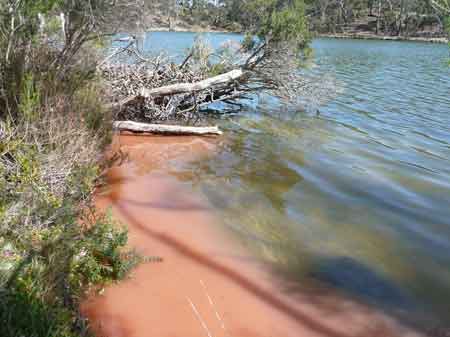
November 2008. Rainbox coloured algal blooms.
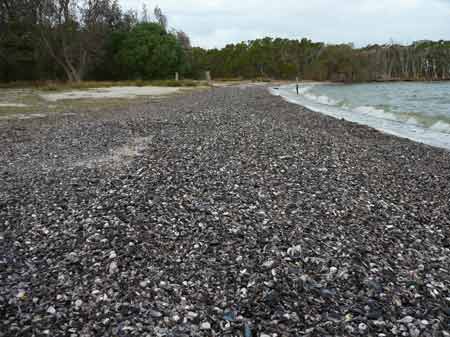
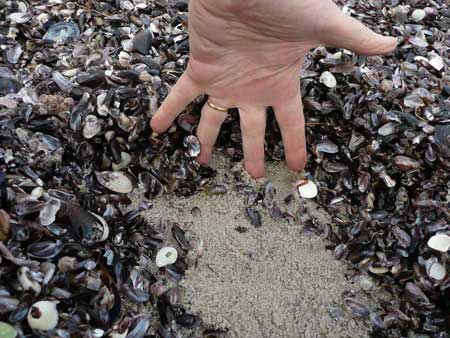
July 3, 2008: mussel shells 300mm deep by 3 meters wide;
4 species of shell at least.























